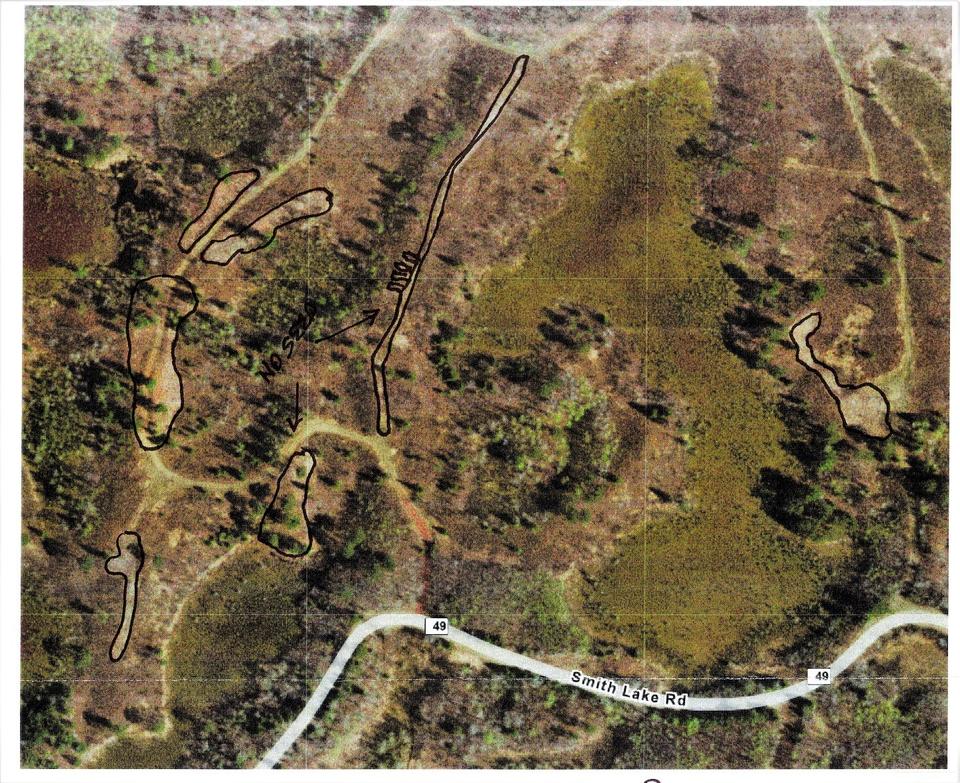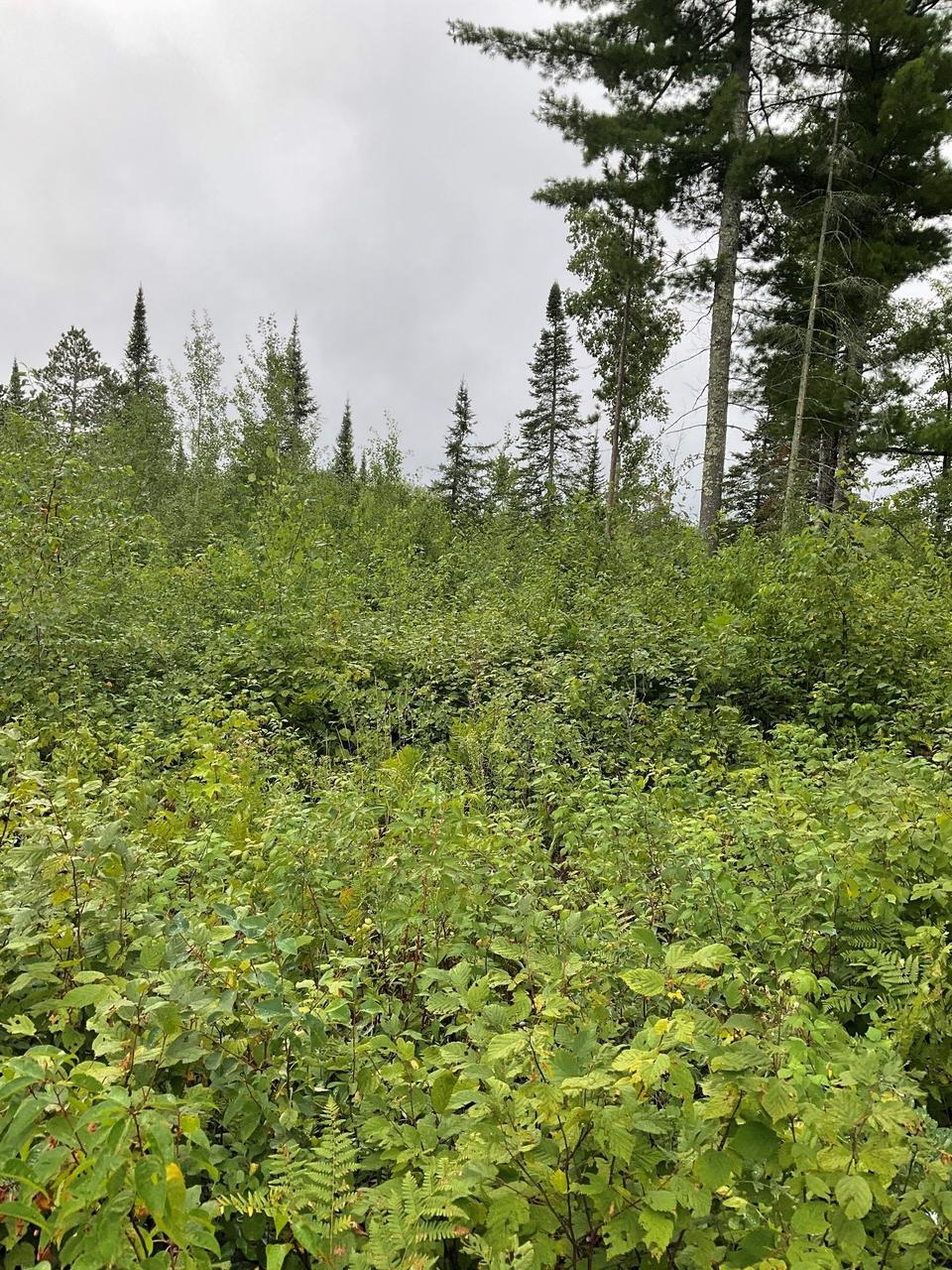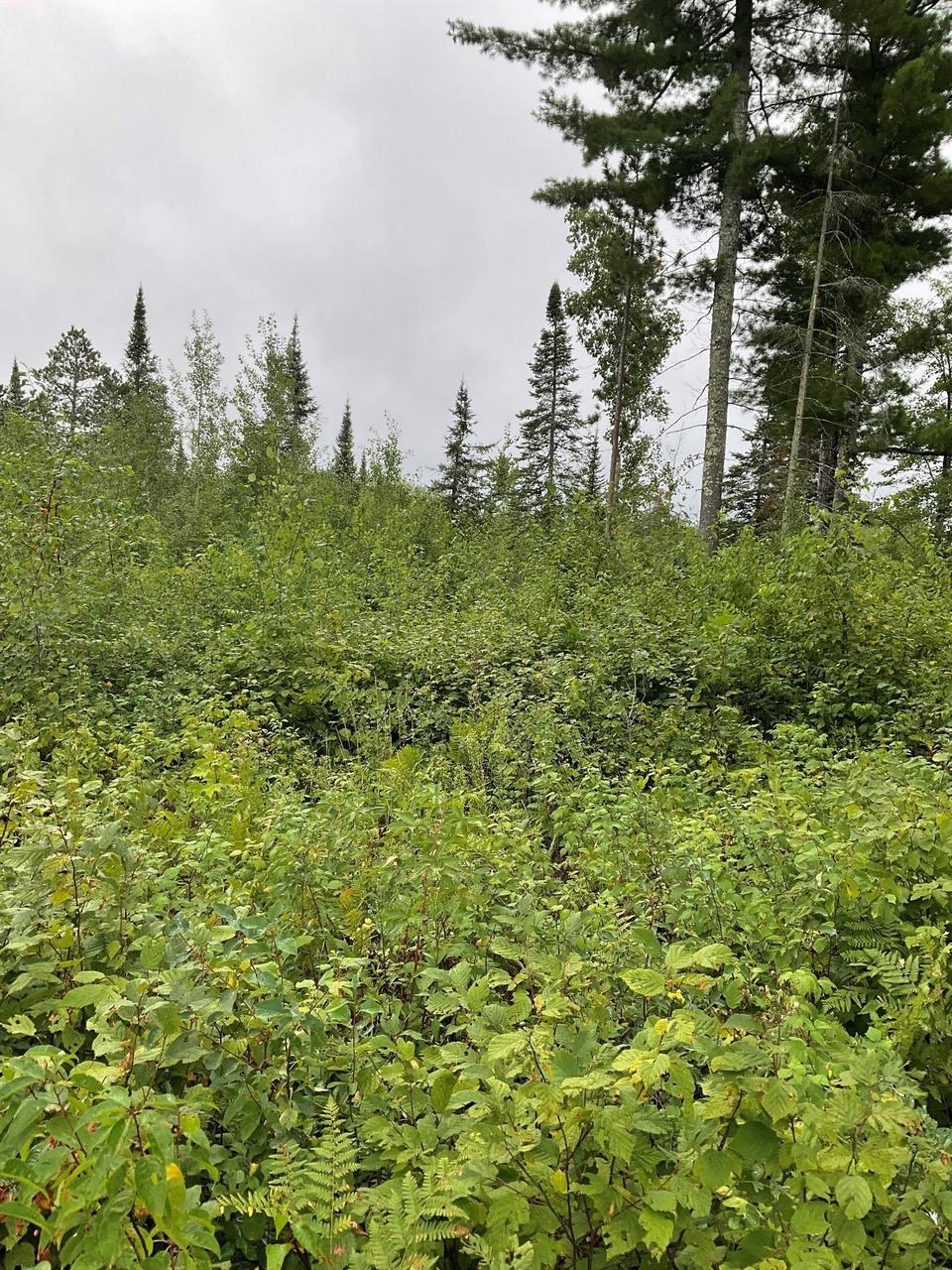Overview
The case study was conducted on a northern mesic hardwood site that had recently been clearcut with reserves. The clearcut was combined with site prep treatments intended to increase the conifer component on site. Patch scarification occurred using a Fecon mulching head attached to to a tracked loader. This was intended to control competition and scarify a seedbed receptive to natural or artificial conifer seeding. Mulching treatments were implemented in small patches to control competition and create a mineral soil seedbed. Mulched patches were either adjacent to a natural seed source or without a natural seed source, in which case they were augmented by direct seeding. Mulching did not have the intended outcomes. Aspen heights and densities were reduced on mulched treatments when compared to unmulched controls. Long lived conifer species were not observed within regeneration survey plots on mulched treatments adjacent to natural seed sources or where direct seeding occured.
Silviculture Objective(s)
The objectives of this prescription were to reinitiate a 43-year-old mixed aspen stand utilizing a clearcut with reserves while increasing long-lived conifers - and thus older successional characteristics - using patch scarification with a mulching head combined with natural and artificial seeding.
Pre-treatment stand description and condition
Stand establishment and management history:
Stand was established through a clearcut in 1969.
Pre-treatment species composition:
Prior to the 2014 harvest, the stand consisted primarily of aspen with some paper birch and scattered super-canopy red pine, white pine, white spruce, and maple trees.
Pre-treatment growth and stocking:
Preharvest inventory in 2013 shows 70 square feet of basal area per acre with 20.5 cords per acre of aspen, 2.8 cords per acre of birch.
Landowner objectives/situation:
Minnesota's Permanent School Fund receives income from economic activities on School Trust Lands which are managed by the MN DNR. Revenue on School Trust Lands is generated from forest management amongst other activities. Forest management activities on School Trust lands are planned and carried out by MN DNR.
As it relates to forest management on School Trust Lands, MN DNR has the authority and responsibility to achieve the goals outlined in Minnesota Statute, Section 84.027, Subd. 18 including:
- manage efficiently and with undivided loyalty;
- reduce operating expenses and maximize revenues deposited in the Permanent School Fund;
- maximize long-term economic returns while maintaining sound natural resource conservation and management principles;
- balance short-term revenues and long-term interests so that long-term benefits are not lost in an effort to maximize short-term gains;
- maintain the integrity of the trust and prevent the misapplication of its lands and its revenues.
Stand-specific objectives were to generate revenue for the permanent school trust fund and diversify cover types in an area with an overabundance of aspen cover types, while increasing long-lived conifers to contribute to the DNR North 4 Section Forest Resource Management Planning (SFRMP) goals.
Silviculture Prescription
Clearcut with reserves with frozen or dry ground operating conditions. Full tree skidding to maximize soil disturbance for natural seeding opportunities from reserved conifer and birch seed trees adjacent to the sale area. Five years post-harvest have at least 100 stems per acre of regenerating site-suitable and long-lived non-aspen tree species.
What actually happened during the treatment
The stand was harvested in late fall 2014 via cut-to-length logging operation, providing little to no scarification.
Regeneration checks in 2015 found 3,000 stems per acre of aspen with no other species regenerating.
Assessment in 2016 found a significant white spruce and white pine cone crop developing. Another good cone year was noted in 2017.
In September of 2017, a local excavating company was contracted to use a Fecon mulching head attached to a tracked loader to remove vegetation and scarify ¼- to ½-acre areas in the seed dispersal zone of residual conifers and also in some areas without conifers. The total area treated was approximately 2 acres. Following the treatment, we hand-seeded a mix of white spruce and white pine seed in areas that did not have residual conifers as a natural seed source.
After 2017, it was clear we had two different treatments and a control with which we could evaluate the effectiveness of the Fecon mulching treatment at establishing conifer from natural and artifical seeding. Those were:
- site prep with Fecon-natural seeding (SP)
- site prep with Fecon-artificial seed (SP-S)
- untreated control area (C)

Figure 1: Project area, showing mulched + seeded areas and mulched + no seed areas.
Post-treatment assessment
Sampling in 2020 found differences between the three treatments. To summarize, in this case the mulching head did not successfully promote conifer regeneration. In some areas, namely the SP treatment, aspen stem density was reduced from 1900 to about 1100. In other areas, aspen density remained high, but was supplemented by birch regeneration due to natural seeding.
The SP treatment had 700 stems per acre of aspen in the 1-3" DBH size class and another 400 in the 0-1" DBH size class.
The SP-S treatment had 1,958 stems per acre of aspen and 100 stems per acre of birch in the 0-1" DBH size class.
The control (C) had approximately 1,900 aspen in the 1-3" class.
No conifers were found in plot on any treatment.

Figure 2: Mulched and seeded area.

Figure 3: General harvest area as control.
Plans for future treatments
No further treatment plans.
Costs and economic considerations
Fecon mulching head costs were $145 per hour for 8 hours work for a total of $1,160, or $580 per acre.
Seeding costs were $395 for 32 oz. white pine seed and 4 oz. white spruce seed, or $198 per acre.
The total cost was $1,554, or $777 per acre of treatment on two acres.
Climate Adaptation Considerations
There were no climate change considerations explicit in the prescription at the time it was developed. However, diversifying species composition by reducing aspen density in favor of long-lived conifers can provide resilience towards climate change.
Summary / lessons learned / additional thoughts
Results indicate that both site prep treatments reduced total stocking and failed to yield an increase in conifer component. There are two possible reasons for the failure of conifer recruitment. The Fecon head created a mulched seedbed, and it failed to provide adequate soil contact for seed germination and survival. The mixed mulch effectively allowed any germinants to dry out and not establish their roots into mineral soil. The reduction in aspen size is likely due to the depth of the mulching setting the aspen roots back. The mulched sites had large components of hazel, Rubus, and vetch that was not present in the control area. This is likely a result of the mulching allowing these species to get establish in the reduced aspen stocking.
A more effective approach to meeting the objective of increasing a long-lived conifer component would be conventional scarification around these sites that exposes mineral soil as opposed to creating a bed of mulch. Site prep techniques such as salmon blading or anchor chaining would likely have been more effective.
This case study was reviewed by MN DNR ECS Staff Ashlee Lehner and Silviculture Program Staff Mike Reinikainen. Case study submitted on 04/24/2023.
